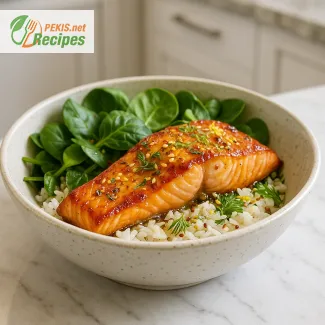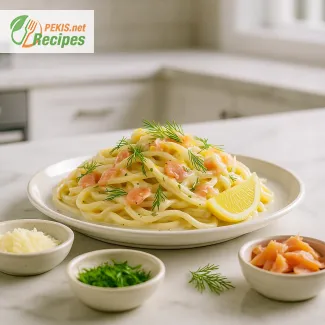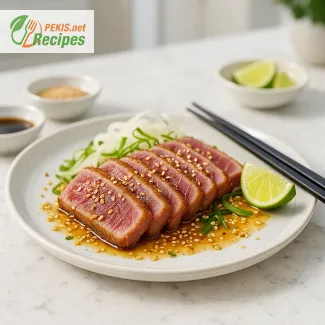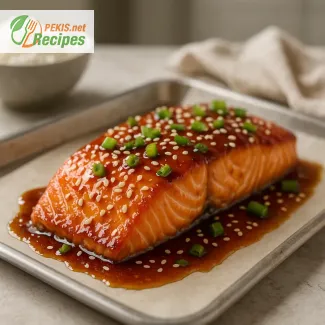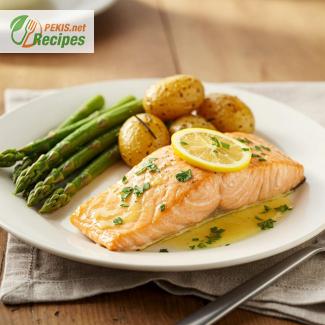
Irresistible Oven-Baked Salmon with a Zesty Lemon Touch
A Perfectly Juicy and Flavorful Salmon Dish
Salmon is one of the most versatile and nutritious fish, loved for its rich flavor, delicate texture, and numerous health benefits. When cooked correctly, it becomes incredibly tender, flaky, and full of depth, making it a favorite among seafood enthusiasts. This baked salmon with lemon sauce is an elegant yet effortless dish, perfect for both a casual weeknight dinner and an upscale gathering.
The key to making perfectly baked salmon lies in the balance of moisture, seasoning, and temperature. Unlike pan-searing or grilling, baking allows the salmon to cook evenly, preserving its natural juices while absorbing the flavors of herbs, citrus, and buttery richness. The result? A succulent, melt-in-your-mouth fillet with a golden exterior and a perfectly flaky interior.
But what truly elevates this dish is the luscious lemon sauce. The combination of fresh lemon juice, creamy butter, and fragrant garlic creates a bright, tangy, and slightly velvety drizzle that enhances the natural sweetness of the fish. The citrus acidity cuts through the richness, creating a well-balanced harmony of flavors. Whether you're serving it with roasted vegetables, a refreshing salad, or a bed of fluffy rice, this oven-baked salmon is bound to impress.
The Secret to a Perfectly Cooked Salmon
One of the most common concerns when cooking salmon is avoiding dryness. Since salmon fillets vary in thickness and fat content, it’s essential to bake them at the right temperature and for the correct amount of time. Overcooking can lead to a tough, chalky texture, while undercooking may leave the fish too raw in the center. The key is to use an optimal baking temperature—typically around 375°F to 400°F (190°C to 200°C)—and to keep an eye on the fillets until they reach the perfect doneness.
A good indicator that salmon is ready is when it flakes easily with a fork but remains slightly translucent in the center. Additionally, using foil or parchment paper helps retain moisture, ensuring a juicy and tender bite every time.
Why Lemon Sauce is the Perfect Pairing for Salmon
Citrus and seafood have always been a classic pairing, and for good reason. The natural acidity of lemon juice not only enhances the flavor of the fish but also helps tenderize it. Combined with garlic, butter, and a touch of honey or Dijon mustard, this silky lemon sauce creates an irresistible coating that makes each bite burst with flavor.
This sauce is not only incredibly delicious but also highly versatile. It can be spooned generously over the salmon, drizzled over steamed vegetables, or even used as a dipping sauce for crusty bread. Its creamy yet zesty consistency makes it an ideal complement to the fish, creating a restaurant-quality dish that you can easily prepare at home.
Health Benefits of Baked Salmon
Apart from its delightful taste, salmon is one of the most nutrient-dense foods available. It is packed with omega-3 fatty acids, which are essential for heart health, brain function, and reducing inflammation. Baking salmon instead of frying it preserves its healthy fats and minimizes unnecessary calories, making it a wholesome and guilt-free meal.
Other notable health benefits of salmon include:
- Rich in high-quality protein – Essential for muscle repair and overall health.
- Loaded with vitamins and minerals – Contains vitamin D, B12, and selenium, which support immune function and metabolism.
- Supports heart health – Omega-3 fatty acids help lower bad cholesterol and reduce the risk of heart disease.
- Boosts brain function – Regular consumption of salmon is linked to improved cognitive function and reduced risk of neurodegenerative diseases.
Ideal Side Dishes to Serve with Baked Salmon
This baked salmon with lemon sauce pairs wonderfully with a variety of side dishes. Whether you're looking for something light and fresh or hearty and satisfying, here are some great options:
Fresh and Light Options
- Garlic butter asparagus – A crisp and vibrant green side that complements the buttery salmon.
- Lemon herb quinoa – A fluffy, nutritious grain that absorbs the flavors of the lemon sauce beautifully.
- Cucumber and avocado salad – A refreshing salad that adds a cooling contrast to the warm salmon.
Hearty and Comforting Options
- Roasted baby potatoes – Crispy on the outside, soft on the inside, and perfect for soaking up the sauce.
- Creamy mashed potatoes – A classic side that adds a comforting, velvety texture to the dish.
- Wild rice pilaf – A nutty and wholesome grain dish that enhances the overall meal.
A Dish for Every Occasion
Whether you're hosting a dinner party, preparing a romantic meal, or simply looking for a quick and healthy dinner, this baked salmon with lemon sauce is an excellent choice. Its delicate yet bold flavors, combined with its simple preparation, make it a go-to recipe for any occasion.
With its tender texture, rich taste, and bright lemony finish, this salmon recipe is a true showstopper. Once you try it, it’s bound to become a staple in your kitchen.
- Preheat the oven to 200°C (400°F). Line a baking tray with parchment paper.
- Prepare the sauce: In a small bowl, whisk together olive oil, fresh lemon juice, minced garlic, melted butter, honey, and Dijon mustard until well combined.
- Season the salmon: Place the salmon fillets on the prepared baking tray. Brush the fillets evenly with the lemon sauce, ensuring full coverage. Sprinkle with salt, black pepper, and paprika.
- Bake the salmon: Place in the preheated oven and bake for 12-15 minutes, depending on the thickness of the fillets. The salmon is done when it flakes easily with a fork.
- Garnish and serve: Remove from the oven and sprinkle with freshly chopped parsley. Serve warm with your preferred side dish.
Elevating the Classic Baked Salmon with Lemon Sauce
How to Enhance the Flavor and Texture of Baked Salmon
Baked salmon with lemon sauce is already a deliciously simple and elegant dish, but there are plenty of ways to refine and elevate it even further. Whether you want to enhance the depth of flavor, improve the texture, or make the dish healthier, small modifications can have a significant impact. By tweaking ingredients, experimenting with cooking techniques, and using high-quality, fresh components, you can turn this recipe into a restaurant-worthy meal at home.
Choosing the Best Ingredients for Maximum Flavor
The quality of ingredients plays a crucial role in achieving the best results. Here’s what you should consider when selecting the core components of this dish:
Selecting the Right Salmon
- Fresh vs. Frozen: Fresh wild-caught salmon typically has a firmer texture and richer taste compared to farmed salmon, which tends to be milder and fattier. If using frozen salmon, ensure it is properly thawed in the refrigerator to maintain its natural moisture.
- Skin-on vs. Skinless: Keeping the skin on while baking helps retain moisture, preventing the fillet from drying out. It also adds a crisp, slightly smoky flavor if seared before baking.
- Thickness Matters: Thicker fillets bake more evenly and stay juicier compared to thinner cuts, which can overcook quickly.
Enhancing the Lemon Sauce
While the classic lemon-butter sauce is bright and flavorful, you can add depth and complexity by incorporating other ingredients:
- White wine: A splash of dry white wine adds a subtle acidity and enhances the citrus notes without overpowering the dish.
- Capers: Their salty, briny flavor balances the richness of the butter and complements the lemony freshness.
- Shallots or red onion: Finely diced shallots give the sauce a mild sweetness and delicate depth that pairs beautifully with salmon.
- Fresh herbs: Adding thyme, dill, or tarragon to the sauce enhances its aromatic complexity and elevates the overall taste.
Avoiding Common Mistakes When Cooking Salmon
Even with the best ingredients, certain mistakes can negatively impact the dish. Here are some common pitfalls and how to avoid them:
Overcooking the Salmon
- Why it happens: Baking salmon for too long at high heat can result in a dry, chalky texture.
- Solution: Use a meat thermometer to check for doneness—salmon should reach an internal temperature of 52-55°C (125-130°F) for a moist, flaky texture.
Skipping the Resting Time
- Why it matters: Allowing salmon to rest for a few minutes after baking lets the juices redistribute, preventing dryness.
- Solution: Let the fillets sit for at least 5 minutes before serving.
Using Too Much Lemon Juice
- Why it’s an issue: While lemon enhances flavor, too much acidity can overpower the salmon’s natural sweetness.
- Solution: Balance lemon juice with a touch of honey or maple syrup for a rounded, well-balanced taste.
Healthier Substitutions Without Compromising Flavor
If you want to make this dish healthier, consider these alternatives:
Butter Substitutes
- Olive oil: A healthier option with a mild fruitiness that complements the lemon sauce.
- Ghee (clarified butter): Offers a rich, buttery taste while being easier to digest.
Reducing Sodium
- Herbs and spices: Instead of extra salt, use garlic powder, smoked paprika, or lemon zest for natural seasoning.
- Low-sodium broth: If adding liquid to the sauce, opt for a low-sodium vegetable or chicken broth instead of salted butter.
Increasing Nutritional Value
- Add nuts: A sprinkle of toasted almonds or walnuts provides healthy fats and a crunchy contrast.
- Serve with quinoa instead of rice: Quinoa is a high-protein, fiber-rich grain that complements the dish beautifully.
Why Homemade Baked Salmon is Better Than Store-Bought Versions
Cooking salmon at home is superior to restaurant or pre-packaged versions for several reasons:
- Control over ingredients: You can choose the freshest, highest-quality ingredients without unnecessary additives.
- Healthier preparation: Many pre-made salmon dishes use excessive butter, salt, and preservatives, which can be avoided at home.
- Customizable flavors: You can adjust the seasonings, herbs, and sauces to suit your preferences.
The Best Side Dishes to Complement This Dish
Pairing baked salmon with the right sides can enhance the dining experience:
- Crispy roasted Brussels sprouts: Their slightly bitter, caramelized flavor contrasts beautifully with the rich, citrusy salmon.
- Garlic mashed cauliflower: A low-carb alternative to mashed potatoes, adding creaminess without the extra carbs.
- Zucchini noodles: Light and refreshing, they absorb the lemon sauce wonderfully while keeping the meal balanced.
By making these simple enhancements, you can take baked salmon with lemon sauce from a great meal to an unforgettable dining experience.
- Contains fish, butter (dairy), and mustard.
- Gluten-free: Suitable for gluten-free diets.
- Substitutions: Replace butter with dairy-free margarine for a lactose-free version. Use maple syrup instead of honey for a vegan alternative.
- Vitamin D: 12 µg (60% DV) – Supports bone health and immune function.
- Vitamin B12: 4.5 µg (188% DV) – Essential for brain function and red blood cell formation.
- Omega-3 fatty acids: 1.8 g – Reduces inflammation and supports heart health.
- Selenium: 42 µg (76% DV) – Helps protect cells from oxidative stress.
- Vitamin C (lemon juice): 8 mg – Boosts immune system and supports collagen production.
- Polyphenols (olive oil): 25 mg – Protects against cellular damage and supports heart health.
